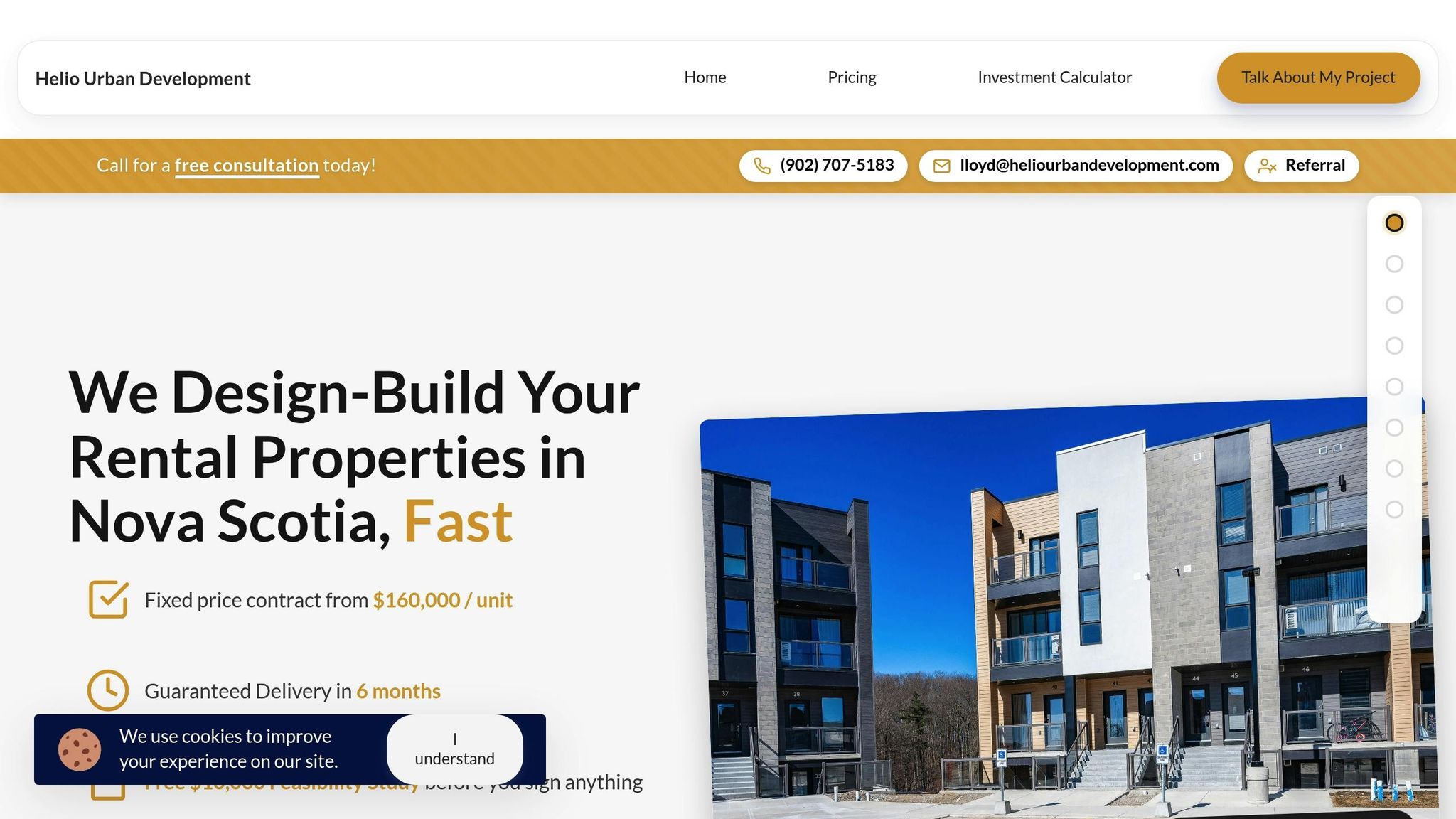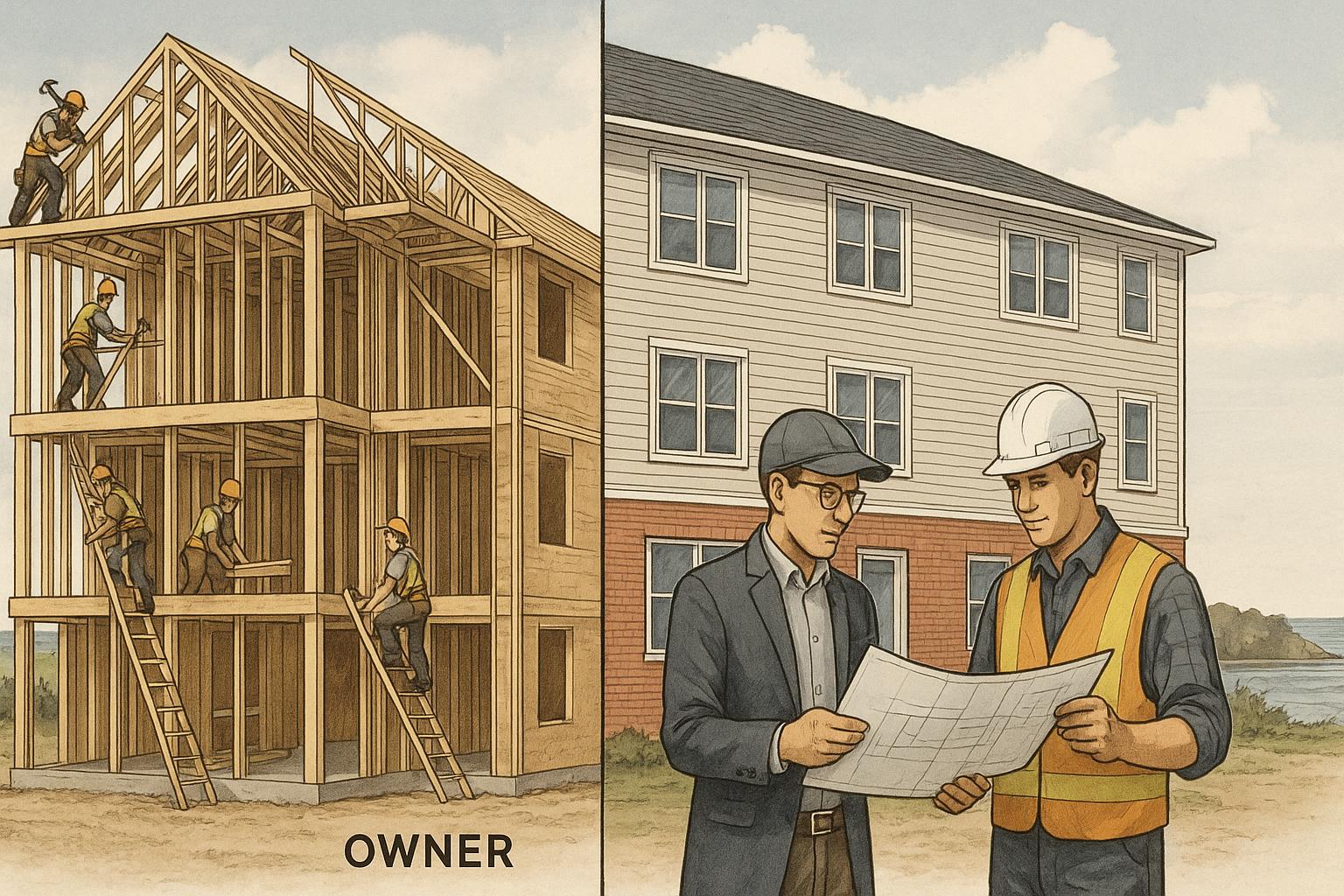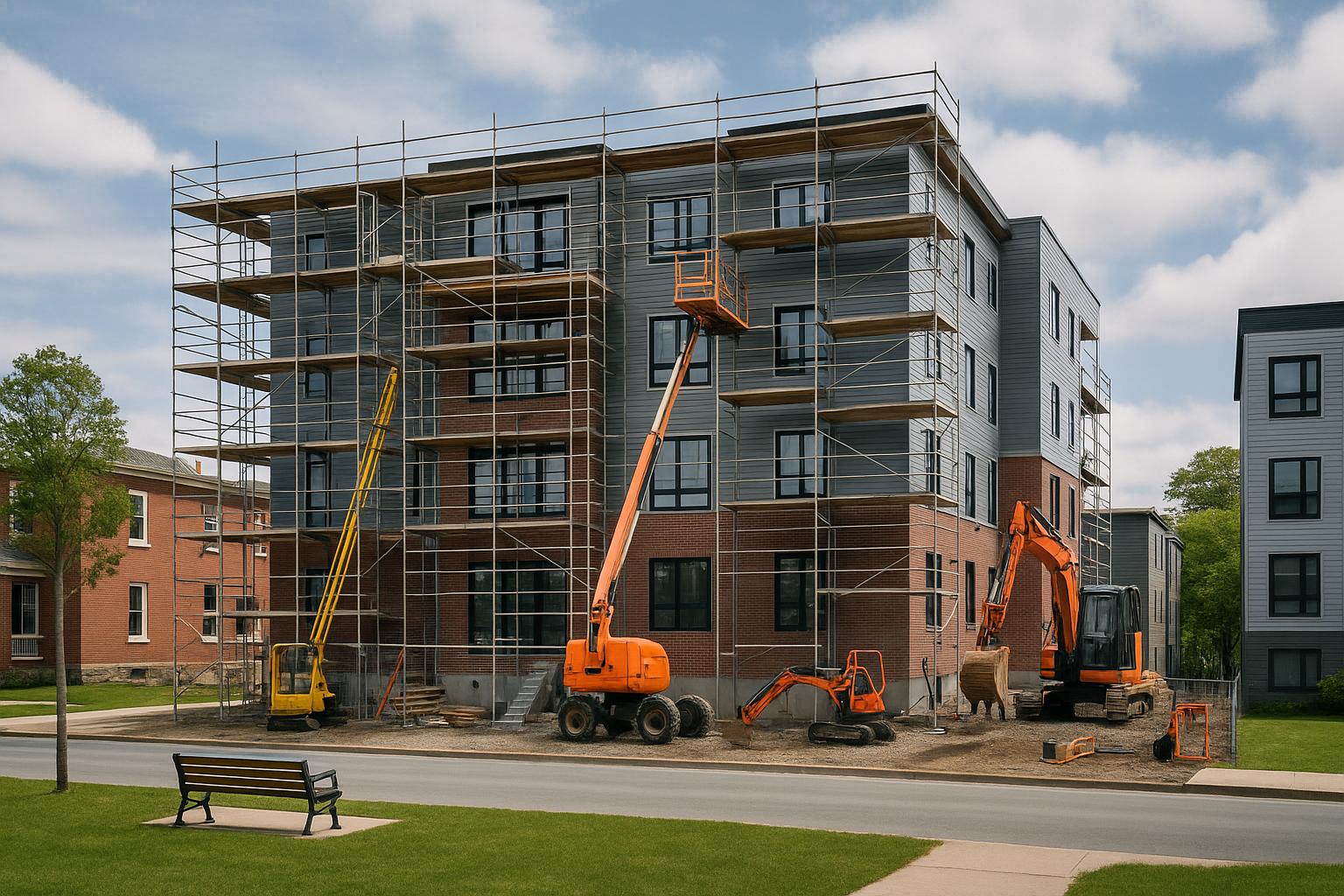HR-1 zoning in Halifax allows property owners to build multi-unit residential buildings like duplexes and small apartments in areas previously limited to single-family homes. While this increases housing options, it also brings challenges such as managing shadow impacts, adhering to stepback and setback rules, and addressing community concerns. Builders must balance compliance with regulations, maximizing rental income, and maintaining good neighbour relations. Integrated design-build teams can simplify the process by handling design, construction, and community engagement under one roof, ensuring smoother approvals and timely project completion.
Saint Patrick’s Alexandra Site Community Consultation
Shadow Issues: How to Reduce Neighbour Problems
HR-1 developments often create shadow-related challenges that can strain relationships with neighbours and potentially delay project approvals. Halifax has recognized the importance of addressing these concerns by requiring detailed shadow studies as part of the approval process.
How Shadows Affect HR-1 Projects
Multi-unit buildings inevitably cast longer shadows, which can reduce natural light and impact outdoor spaces. This issue becomes more pronounced during Halifax's shorter winter days when the sun is lower in the sky. Even minor shadows that seem negligible in summer can become a concern from October through March, as they may significantly limit daylight hours.
Neighbourhood conflicts over these issues have become a notable challenge for Halifax. As Councillor Sam Austin from Dartmouth Centre remarked regarding such disputes:
"It's been a massive resource suck." [3]
Halifax Rules for Shadow Studies
Anyone planning an HR-1 development in Halifax's Regional Centre should be prepared to include a Shadow Impact Assessment in their application [2]. Halifax's municipal planning strategies outline the need for these studies, but the specific requirements depend on the project's scale and location [1]. For instance, provincial guidelines for wind turbines limit shadow flicker on residential properties to less than 30 minutes per day or 30 hours per year, offering a glimpse into what the city might consider acceptable shadow impacts [1].
A shadow study typically maps out how shadows will fall across different seasons, with a particular focus on the winter months. It also needs to demonstrate how the design mitigates potential impacts on neighbouring properties.
Building Design to Reduce Shadows
Once shadow patterns are identified, thoughtful design becomes key to minimizing their effects. A few strategies can help reduce shadow impacts while maintaining the building's functionality.
- Optimal orientation: Position the building's longest side along an east–west axis to limit shadow spread.
- Step-down design: Gradually reduce the building's height to lessen its massing and shadow reach.
- Increased setbacks: Even a small adjustment, like adding a metre, can significantly reduce shadow encroachment.
In addition, architectural elements such as recessed balconies or varied rooflines can break up the building's mass, creating more dynamic and less intrusive shadow patterns. Prioritizing designs that minimize shadows during peak outdoor activity times - typically late morning to mid-afternoon - can also help prevent complaints from neighbours. These thoughtful approaches not only address shadow concerns but also contribute to smoother project approvals.
Stepbacks and Setbacks: Meeting Rules While Maximizing Space
If you're planning an HR-1 project in Halifax, understanding stepbacks and setbacks is non-negotiable. These rules shape your building’s footprint, height, and even your rental income potential. Getting a handle on them early can save you from expensive redesigns and streamline the approval process.
Stepbacks vs. Setbacks: What's the Difference?
The distinction is straightforward but important. Setbacks dictate how far your building must be from property lines to maintain privacy and space between structures. Stepbacks, on the other hand, require upper floors to "step back" or recede, reducing the building's visual bulk and creating a tiered effect.
HR-1 Stepback and Setback Rules
Halifax’s HR-1 zoning comes with specific guidelines that vary depending on your lot size and location within the Regional Centre. Setbacks for the front, sides, and rear of your property are designed to provide privacy buffers and ensure functional space around the building. These distances aren’t uniform - they depend on the neighbourhood and lot context.
Stepback rules, meanwhile, typically require upper floors to recede from the front facade, giving the building a tiered appearance. In some cases, there may also be stepback requirements for side elevations, particularly when your property borders lower-density residential areas.
The exact dimensions for both setbacks and stepbacks depend on factors like your lot’s characteristics and its surrounding environment. For example, corner lots or properties in areas with heritage considerations might have unique requirements. Navigating these rules effectively is essential to designing a compliant building that also maximizes rental potential.
Design Ideas to Maximize Rental Space
Meeting setback and stepback requirements doesn’t have to mean sacrificing rentable square footage. Smart design strategies can help you strike the perfect balance:
- Tiered Building Shapes: Use a tiered design to naturally meet stepback rules while creating private outdoor spaces like terraces or balconies on the recessed levels. These features not only comply with regulations but also offer desirable amenities for tenants.
- Maximize the Lower Floors: Focus on maximizing the footprint of the lower levels, which typically allow for larger units. Then, use the stepped-back upper floors for smaller, more efficient units. This arrangement works well for catering to different tenant demographics, such as families on the lower floors and young professionals or couples on the upper levels.
- Integrate Outdoor Features: Incorporate recessed balconies or rooftop amenities to create appealing outdoor areas without violating setback limits.
- Vary Floor Plate Sizes: Adjust the size of each floor to align with market demand. For instance, the lower levels could house spacious family units, while the compact upper floors might attract tenants seeking affordable, efficient spaces.
To navigate these complexities, consider working with an integrated design-build team. Unlike the traditional approach where architects, engineers, and contractors operate separately, an integrated team collaborates from the start. This ensures your design meets all regulations, maximizes space, and keeps construction costs predictable. Plus, thoughtful design can help maintain good relationships with neighbours, which is always a bonus.
sbb-itb-16b8a48
Neighbour Relations: Avoiding Problems and Building Support
Fostering good relationships with neighbours can save time and money. HR-1 projects that face pushback from the community often encounter delays, increased costs, and long-term challenges. Addressing concerns early and showing how the project benefits the broader community are key steps to avoiding these issues.
Common Neighbour Complaints About HR-1 Projects
Parking is a frequent concern. Neighbours often fear that new units will increase competition for on-street parking, even if the project complies with municipal parking requirements. Thoughtful parking design can help ease these worries and maintain community goodwill.
Just as design tweaks can address issues like shadows and setbacks, early engagement with neighbours can smooth the approval process and keep community support intact.
How to Prevent Neighbour Disputes
- Start the Conversation Early: Don’t wait for formal consultations - reach out to nearby residents as soon as your plans begin to take shape. Sharing early designs and inviting feedback can help uncover potential concerns and guide adjustments before they become obstacles.
- Be Transparent: Provide a clear summary of your project, including details like the number of units, parking plans, construction schedule, and key design features. This kind of openness can counteract misunderstandings and align your project with Halifax’s vision for diverse, inclusive communities.
- Make Small Design Adjustments: Simple changes, like repositioning windows, adding landscaping, or tweaking architectural details, can go a long way in addressing neighbour concerns without derailing your plans.
- Plan for Construction Disruptions: Create a construction communication plan that outlines key details like working hours, regular updates, and a direct contact for any issues. Sharing this plan in advance can help reduce disruptions and reassure the community.
By taking these proactive steps, builders can address concerns early and maintain smoother relations throughout the project.
How Integrated Builders Handle Neighbour Relations
Integrated builders take these efforts a step further by managing design, engineering, and construction under one roof. This unified approach allows them to quickly adapt plans to address concerns, avoiding the delays that often come with fragmented teams.
This approach is particularly effective during public consultations. For example, if neighbours raise concerns about parking or building design, the integrated team can immediately evaluate and implement changes without veering off schedule or budget.
The benefits extend into the construction phase as well. Helio, for instance, keeps neighbours informed with daily updates and adheres to a guaranteed six-month timeline, significantly cutting down on the disruptions that often occur with projects that stretch out for eight to 18 months due to coordination hiccups.
Lloyd Liu, Helio’s co-founder, plays an active role in neighbourhood discussions, personally reviewing each project. With his background in both finance and construction, he’s able to clearly explain the economic and design decisions behind each project. This transparency helps neighbours understand the reasoning behind key choices while also pinpointing ways to address their concerns effectively.
Integrated Construction vs. Multiple Contractor Approach
In our earlier discussion on the challenges of managing multiple contractors in HR-1 projects, we touched on the complexities this approach brings. Now, let’s explore how an integrated design-build model compares. Building HR-1 properties in Halifax often requires juggling architects, engineers, general contractors, and trades, which can lead to coordination headaches, missed deadlines, and budget overruns. Integrated design-build firms simplify this process by consolidating all services under one roof, making it easier to address issues like shadow and setback requirements.
Main Differences Between Integrated and Multiple Contractor Models
The traditional approach divides responsibilities among various contractors, each with its own agenda and timeline. This often leads to delays, especially when design changes are needed. Integrated teams, however, can adapt swiftly, avoiding the bottlenecks that occur when separate contractors need to coordinate.
With integrated construction, there’s single-point accountability from design through to completion. This means issues like shadow or stepback modifications are resolved quickly, without the back-and-forth typical of traditional methods.
Another key distinction is cost predictability. In traditional projects, unforeseen issues can inflate costs as contractors discover new problems. By contrast, integrated design-build projects are often completed 33% faster and at a lower cost, thanks to early identification of potential challenges [6]. Additionally, integrated teams can overlap design and construction phases, significantly shortening project timelines - a clear advantage over traditional multi-contractor setups [6][7][9].
Benefits of Integrated Design-Build for HR-1 Projects
HR-1 projects in Halifax face unique hurdles, from regulatory requirements to community concerns. Integrated construction teams are well-suited to tackle these challenges. When city planners request shadow study updates or neighbours raise concerns about building height, integrated teams can assess and implement solutions immediately, bypassing the delays common with fragmented teams.
Fixed pricing is another major advantage. Property owners know their costs upfront, avoiding the budget overruns and unexpected expenses that often plague traditional projects [4][6][7][9].
Collaboration within an integrated team ensures smooth communication and quick resolutions. Whether it’s adjusting stepbacks or modifying designs to address shadow concerns, the same team handles both the architectural and construction aspects simultaneously [5][7][8][9].
Neighbour relations also benefit. Instead of deferring questions with “I’ll check with my architect,” integrated builders can provide immediate answers and act on concerns without lengthy negotiations between multiple parties.
Case Example: Helio Urban Development

The advantages of the integrated model are clearly demonstrated by Helio Urban Development. As the only integrated design-build company in Nova Scotia specializing in 4+ unit rental properties, Helio eliminates the coordination issues that often arise with multiple contractors. Their approach is tailored to HR-1 challenges, addressing everything from shadow impacts to stepback adjustments, while ensuring compliance with regulations and maintaining positive neighbour relations.
Helio offers fixed-price construction at C$160,000 per unit with a six-month completion guarantee. If delays occur, they pay penalties of up to C$1,000 per day. This level of certainty allows property owners to plan for rental income without worrying about the extended timelines typical of traditional projects.
Co-founders Liu and Yuan He bring a unique edge to Helio. Liu’s investment banking experience at Merrill Lynch and Yuan He’s data science expertise from the University of Pennsylvania have resulted in a systematic approach to scheduling. This method was designed to address the coordination issues that plagued their first project before Helio’s establishment.
With 31 units under construction and 131 more in the pipeline across Nova Scotia, Helio showcases how integrated construction can scale without compromising on quality or deadlines. Property owners receive daily photo updates and have direct access to decision-makers, ensuring any neighbour concerns or design changes are addressed promptly.
Helio’s 2-bedroom units achieve monthly rents of C$1,950–2,100, delivering a 12–20% annual ROI. This highlights how integrated construction can combine operational efficiency with strong financial returns in Halifax’s HR-1 market.
Conclusion: Building Success in Halifax's HR-1 Zone
Achieving success with HR-1 projects in Halifax goes beyond simply adhering to zoning rules. It requires a well-thought-out strategy that balances regulatory compliance, community relationships, and efficient construction practices. Property owners who grasp the importance of shadow impacts, stepback requirements, and neighbourhood concerns are better positioned for smooth approvals and long-term gains.
Incorporating shadow studies and stepback requirements early in the planning process is crucial. These elements are not just regulatory hurdles - they shape the design itself. Addressing them upfront helps avoid expensive redesigns and lengthy approval delays that could derail project timelines.
Equally important is fostering strong community relationships. In Halifax's established neighbourhoods, neighbour relations can make or break an HR-1 project. The difference between a seamless approval process and prolonged opposition often hinges on proactive communication. Property owners who engage with neighbours early, keep them informed, and remain transparent throughout construction tend to face fewer complaints and achieve faster approvals.
Construction methods also play a critical role in determining a project's success. Disjointed teams can slow down essential design adjustments, especially when responding to setback issues or community feedback. A cohesive team ensures that changes are implemented quickly and efficiently, keeping the project on track.
Helio Urban Development exemplifies this integrated approach, offering predictable timelines and reliable results. With their system, property owners benefit from guaranteed six-month project completions, daily photo updates, and direct access to decision-makers. This hands-on approach ensures that neighbour concerns are addressed promptly, avoiding unnecessary delays caused by miscommunication or coordination issues.
Efficient construction practices not only save time and money but also help maintain positive relationships with neighbours - an essential factor for long-term rental success. By aligning design, execution, and community engagement, property owners can set the stage for a successful project.
In Halifax's HR-1 zone, success is all about strategy. Mastering regulations, building trust with neighbours, and partnering with a construction team that offers integrated solutions are the keys to thriving in this space.
FAQs
How can HR-1 builders in Halifax address neighbour concerns about shadows and streamline project approvals?
To ease concerns about shadow impacts, HR-1 builders in Halifax should focus on incorporating setbacks and stepbacks into their designs. These adjustments help reduce shading on nearby properties and show respect for the surrounding community, while also meeting zoning requirements.
Engaging with neighbours early through open dialogue and consultations is crucial. By sharing plans for reducing shadow effects and being receptive to feedback, builders can foster trust and minimize opposition. Aligning projects with Halifax’s urban planning priorities - such as maintaining neighbourhood harmony and promoting environmental balance - can also pave the way for smoother approvals and stronger community relationships.
What’s the difference between stepbacks and setbacks in HR-1 zoning, and how do they impact building design and rental potential?
In HR-1 zoning, setbacks refer to the minimum distance a building must maintain from its property lines - like side or rear yards. For example, near ER zones, this distance is typically around 6.0 m. Setbacks play a key role in maintaining privacy, preserving the character of the neighbourhood, and determining the building’s footprint.
Stepbacks, however, deal with the upper floors of a building. These are horizontal offsets required above a certain height, such as 11.0 m or the height of the streetwall. Stepbacks help reduce the visual impact of taller buildings, improve the overall streetscape, and limit shadowing on nearby properties.
Together, setbacks and stepbacks influence the shape and mass of a building. A well-thought-out design that adheres to these guidelines can create properties that are not only attractive but also balance higher density with a sense of liveability - making them more appealing for rental opportunities.
What are the advantages of using an integrated design-build approach for HR-1 multi-unit projects in Halifax?
An integrated design-build approach can greatly simplify HR-1 multi-unit projects in Halifax, making the entire construction process more efficient. This method provides property owners with a single point of accountability, which means clearer communication, fewer delays, and a seamless journey from the initial design phase to project completion.
This strategy is particularly helpful when dealing with Halifax's intricate HR-1 zoning rules and stepback requirements. By involving designers and builders from the outset, it reduces potential risks, ensures better compliance with regulations, and helps optimize rental opportunities. Unlike traditional methods that require juggling multiple contracts, the design-build approach cuts down on uncertainty, leading to more consistent and reliable results.



